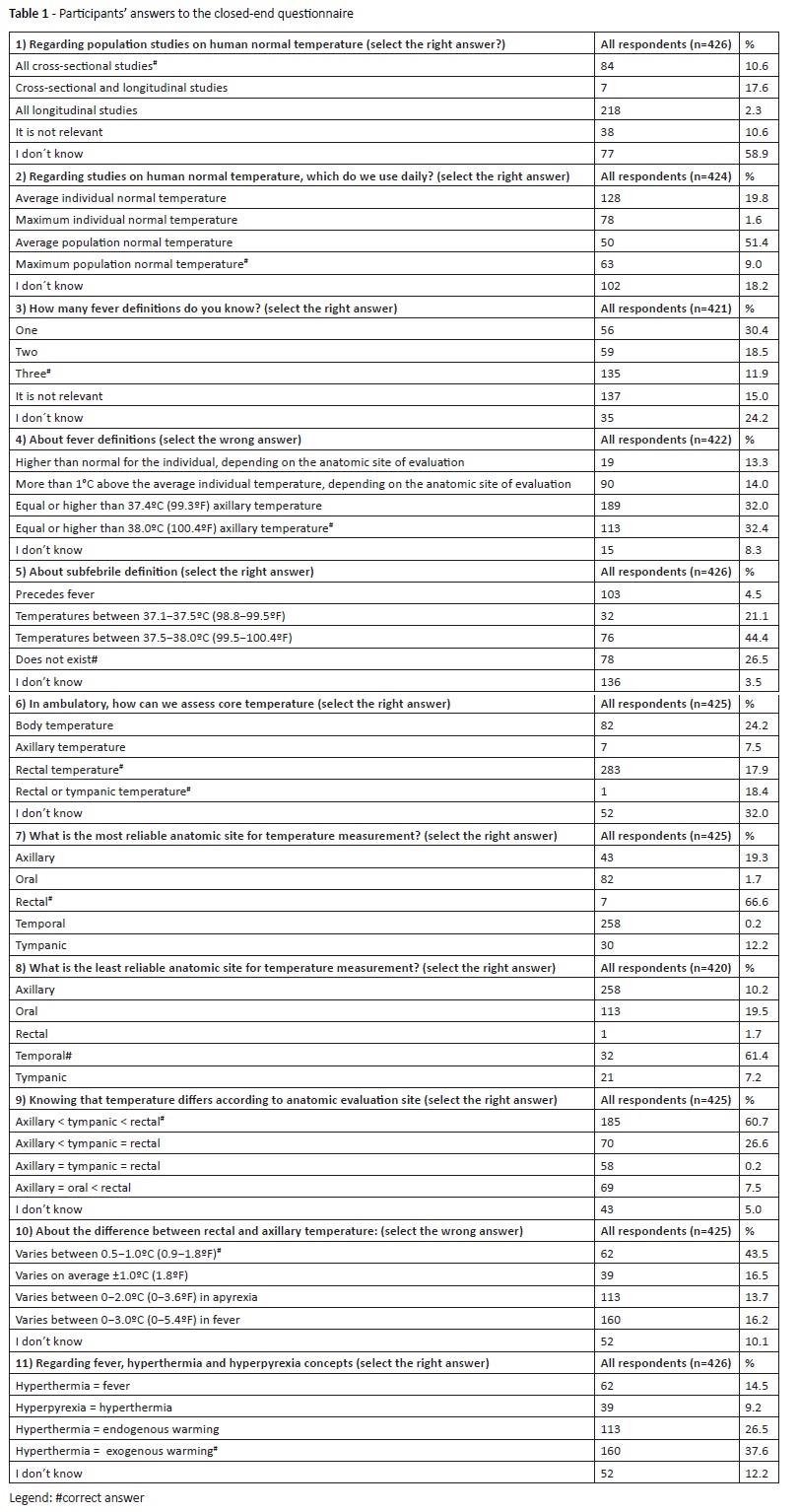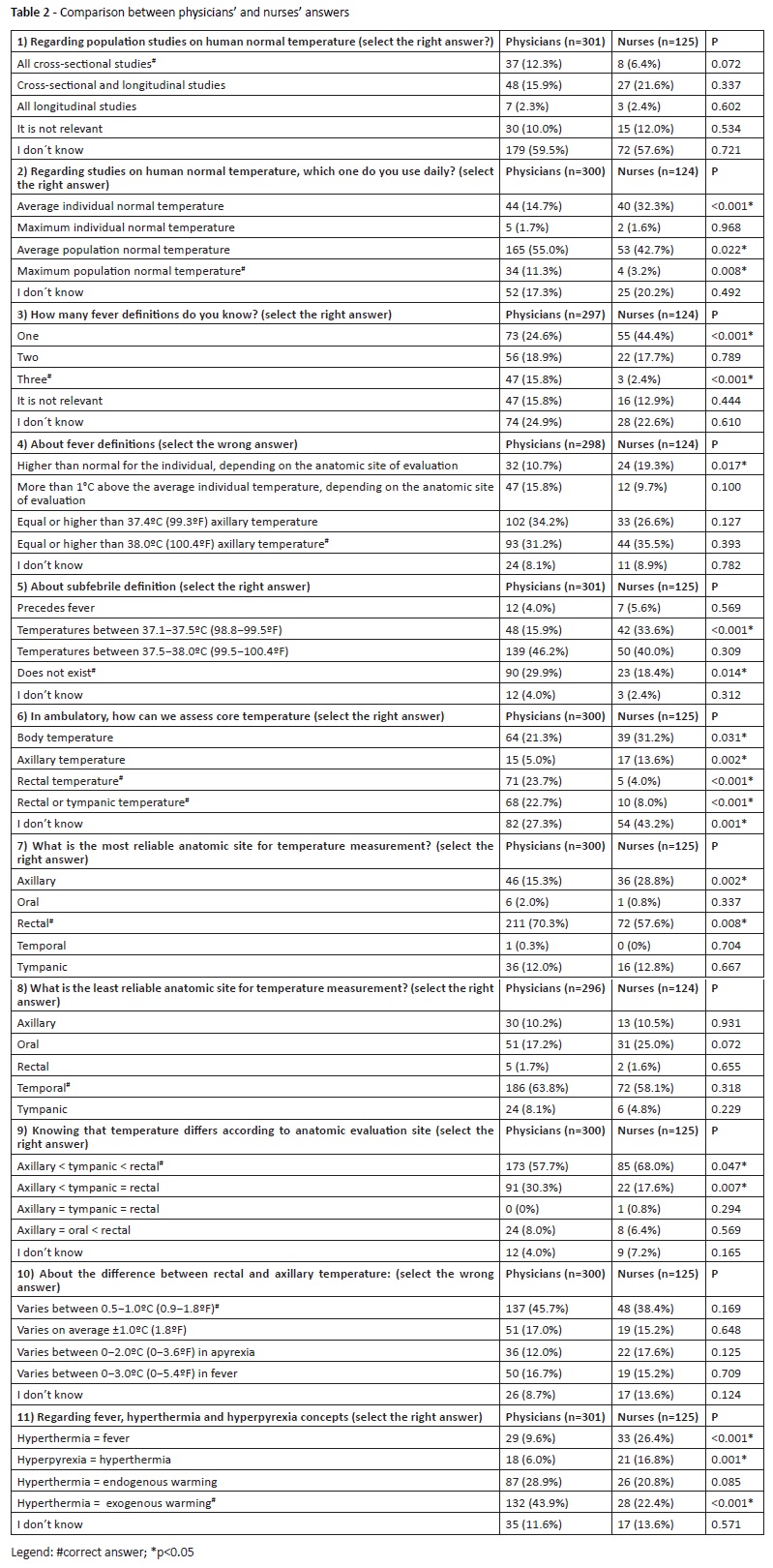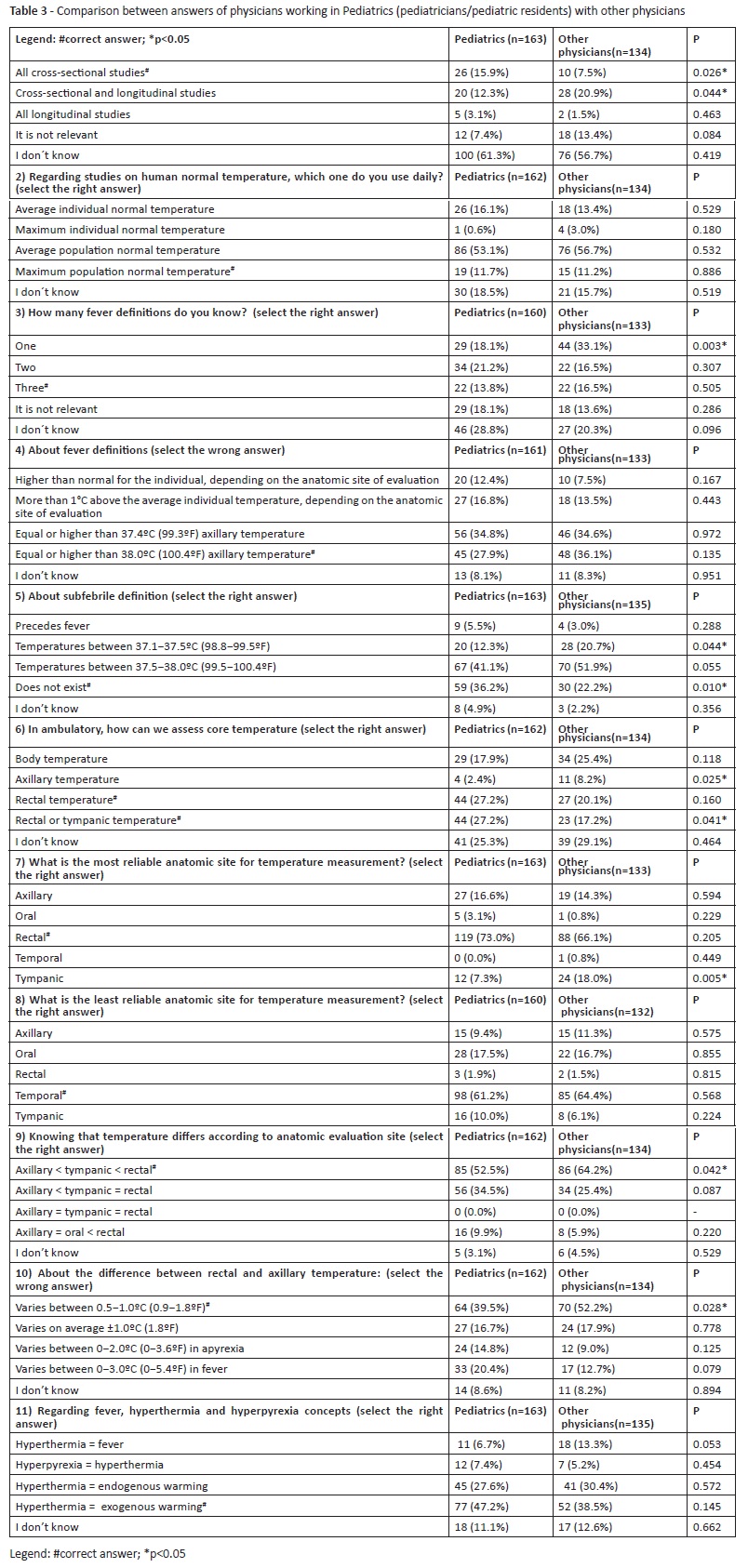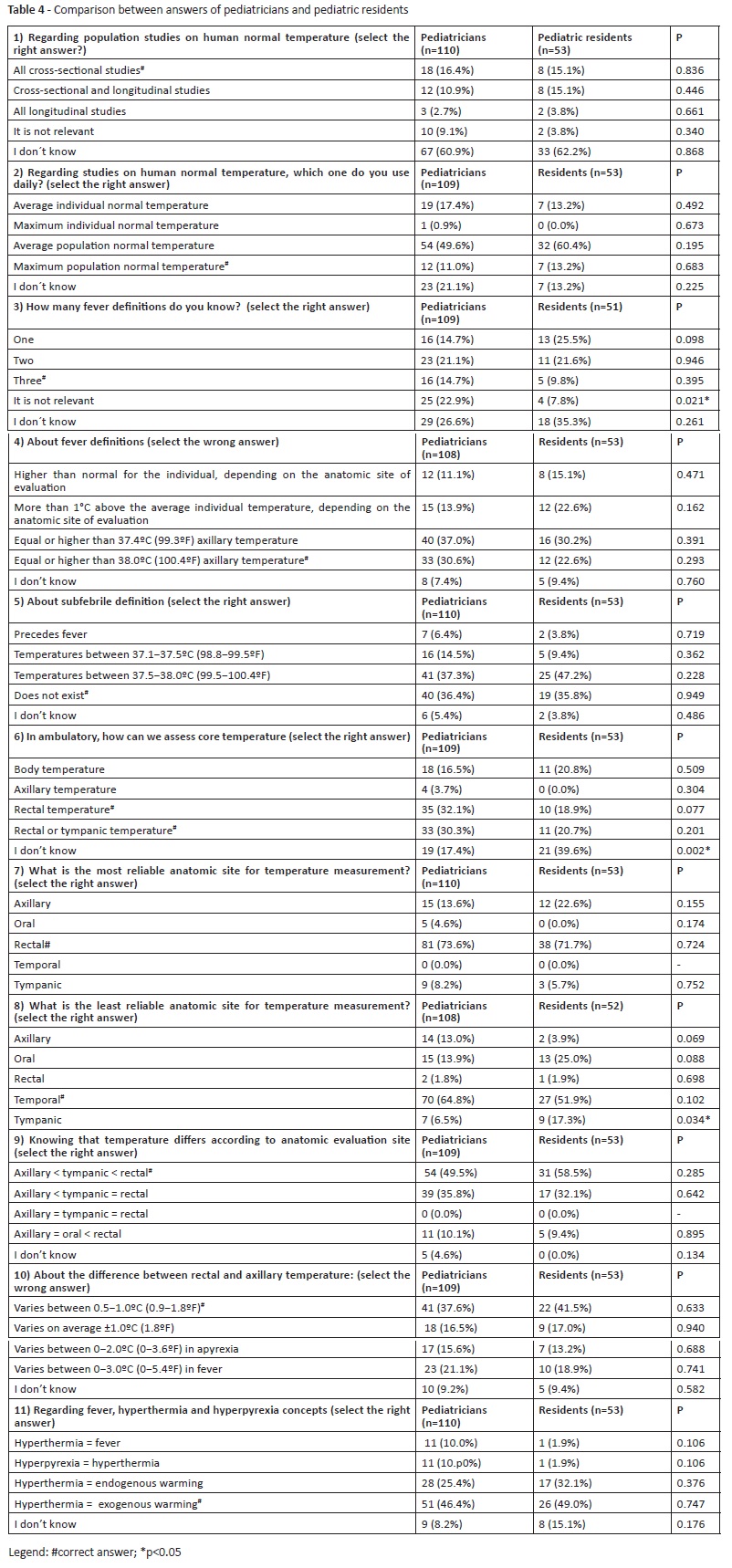Serviços Personalizados
Journal
Artigo
Indicadores
-
 Citado por SciELO
Citado por SciELO -
 Acessos
Acessos
Links relacionados
-
 Similares em
SciELO
Similares em
SciELO
Compartilhar
Nascer e Crescer
versão impressa ISSN 0872-0754versão On-line ISSN 2183-9417
Nascer e Crescer vol.28 no.4 Porto dez. 2019
https://doi.org/10.25753/BirthGrowthMJ.v28.i4.17730
ORIGINAL ARTICLES | ARTIGOS ORIGINAIS
Fever and clinical thermometry: what do physicians and nurses really know?
Febre e termometria clínica: o que sabem realmente médicos e enfermeiros?
Catarina NevesI, Inês Romão LuzI, Manuel SalgadoI
I Pediatric Reumatology Unit, Hospital Pediátrico, Centro Hospitalar e Universitário de Coimbra. 3000-602 Coimbra, Portugal. catarinarneves@hotmail.com; inesluz1988@gmail.com; mbsalgado27@gmail.com
Endereço para correspondência | Dirección para correspondencia | Correspondence
ABSTRACT
Introduction: Fever is a leading cause of Pediatric visits. However, most studies used as reference for fever assessment had a cross-sectional design and were conducted in adults. Different and more precise fever definitions exist within the field of knowledge known as clinical thermometry.
Aims: To assess basic knowledge of health professionals working in Pediatrics regarding fever physiopathology and clinical thermometry.
Material and Methods: A cross-sectional analytical study was performed between February and July 2014 through application of an anonymous closed-end questionnaire to health professionals.
Results: From 426 questionnaires applied, 29% were completed by nurses and 71% by physicians. Within the whole group, 89% did not know how human “normal temperature” was determined, 70% did not recognize the “individual definitions” of fever, 33% acknowledged a “subfebrile” status, 39% did not recognize the most and least accurate anatomical sites for temperature measurement, and 57% did not recognize the dynamic difference between core and peripheral temperatures. Hyperthermia and fever definitions were confounded by 78% of nurses and 56% of physicians.
Conclusions: Most health professionals surveyed had a limited knowledge of fever and clinical thermometry. The traditional oversimplification of this subject can lead to underestimation of true febrile statuses.
Keywords: Clinical thermometry; fever; healthcare professionals; normal temperature
RESUMO
Introdução: A febre é uma das principais causas de consulta pediátrica. Contudo, a maioria dos estudos utilizados como referência para avaliação da febre tiveram um desenho transversal e avaliaram populações adultas. Existem outras definições de febre, mais precisas, que se enquadram numa área de estudo designada por termometria clínica.
Objetivos: Avaliar os conhecimentos básicos dos profissionais de saúde atuantes na área da Pediatria sobre fisiologia da febre e termometria clínica.
Material e Métodos: Estudo analítico, transversal, conduzido entre fevereiro e julho de 2014, efetuado por aplicação de um questionário anonimizado, com perguntas fechadas, a profissionais de saúde.
Resultados: De um total de 426 questionários, 29% foram preenchidos por enfermeiros e 71% por médicos. Considerando o grupo total, 89% desconhecia como a “temperatura normal” em humanos tinha sido determinada, 70% não reconhecia as “definições individuais” de febre, 33% acreditava no estado “subfebril”, 39% não reconhecia os locais anatómicos mais e menos precisos para a medição da temperatura e 57% não reconhecia a diferença dinâmica entre as temperaturas periférica e central. As definições de febre e hipertermia foram confundidas por 78% dos enfermeiros e 56% dos médicos.
Conclusões: A maioria dos profissionais de saúde que responderam ao questionário evidenciou conhecimentos limitados sobre febre e termometria clínica. A tradicional simplificação do tema pode contribuir para a subestimativa de verdadeiros estados febris.
Palavras-chave: febre; profissionais de saúde; termometria clínica; temperatura normal
Introduction
Fever is the most frequent cause of Pediatric Emergency Department visits (approximately 20% of cases), accounting for more than 30% of urgent Pediatric private practice consultations.1-6 Several studies have investigated caregivers’ knowledge of clinical thermometry, fever and its treatment, largely focused on misconceptions regarding the concept of fever phobia.5,7-10 Many health professionals have fever phobia and pass it on to caregivers.1,7,9-14 This phobia can be justified by their misconceptions about “normal temperature”, different fever definitions, and clinical thermometry.7,15,16
A healthy human body regulates its core temperature to values within ±0.2°C of the “average” and peripheral temperature narrowly varies between ±1.0ºC (1.8ºF) or ±2.0ºC (3.6ºF) of the average, aside from environmental temperature changes.15,17,18
The various peripheral (or external) body temperatures do not reflect the core temperature and vary according to anatomical site of measurement.2,15,17,19
Fever is difficult to define. The traditional definitions of “normal temperature” originated from cross-sectional populational studies and described temperatures above the 99th or 97.5th percentiles of the population’s body temperature.2,4,15,18,20-22 The consideration that a single number, currently acknowledged to vary according to measurement site, can represent the thermal status of the entire body is inaccurate.18,19,23 Only with an individual-centred definition can the concept of fever take into account the temperature variability within a single person. Thus, one possible fever definition can refer to the temperature above the individual’s normal daily variation, depending on the anatomical site of measurement.2,18,24-25
Since most people do not know their normal body temperature and considering that the individual temperature varies ±1.0ºC (1.8ºF) of their own average temperature, the following individual fever definition can be accepted: temperature ≥1.0ºC (1.8ºF) of the individual’s average temperature on a specific anatomic location.2,18
The subfebrile concept, although widely used in clinical practice, is not mentioned in renowned scientific books.26,27 It was probably the result of applying a general population fever definition to a particular individual plus the need to treat patients with low-grade fever.18,28,29 Therefore, the traditional fever definitions can lead to misinterpretation of the real condition of many patients with low physiological temperature and thus low-grade fever.
Thermometry, which includes clinical thermometry, is the science that studies body temperature as well as methods and accuracy of anatomic sites for temperature quantification.20,30
If in fever research studies it is mandatory to provide a number to define fever, in clinical evaluation and treatment of a patient with fever it is key to correctly recognize the individual “normal temperature” and to accurately evaluate temperature in the anatomical peripheral site that most accurately reflects his core temperature.2,17 Some experts have sought to devise formulas for converting axillary and oral temperatures into rectal temperature.15,31 However, the changeable nature of thermoregulation justifies the dynamic and Gaussian differences observed between core and peripheral temperatures.2,17,18,22
The aim of this study was to evaluate physicians’ and nurses’ knowledge on human “normal temperature”, fever, and clinical thermometry.
Material and methods
A cross-sectional analytical study was conducted between February and July 2014 by application of an anonymous closed-end questionnaire to physicians and nurses. The questionnaire was developed by the authors and initially validated in a small sample (thirty-eight physicians and one nurse), with subsequent modifications if required. The questionnaire was then e-mailed or personally distributed, using a convenience sample. Only questionnaires with more than 90% of questions answered were considered valid.
Three fever definitions were considered: 1) traditional temperature, i.e. above the populations’ “normal temperature” at a specific anatomic site (above the 97.5th or 99th percentiles); 2) temperature above the individual “normal temperature” at a specific anatomic site; and 3) temperature 1.0ºC (1.8ºF) above the individual average temperature at a specific anatomic site.2,4,18,23-25
The ‘subfebrile’ status was considered an erroneous or non-existing concept.18,29 The traditional fever definition for each anatomical evaluation site were adopted: rectal temperature ≥38.0°C (100.4ºF), axillary temperature ≥37.4ºC (99.3ºF), tympanic temperature ≥37.6ºC (99.7ºF), oral temperature ≥37.5ºC (99.5ºF), and temporal temperature ≥37.7ºC (99.9ºF).2,4,11,18,32,33
The non-invasive methods for temperature assessment that theoretically better correlate with core temperature are the rectal and tympanic temperatures; rectal was considered the standard and most reliable non-invasive measurement method, while tympanic was considered the least reliable method.4,6,17,19,20,22,23,32-35 Within the same individual, rectal temperature was assumed to be the highest and tympanic temperature was assumed to be higher than axillary temperature; rectal temperature was assumed to be, on average, about 1.0ºC (1.8ºF) above the axillary temperature by electronic thermometers, both in apyrexia and fever, varying between 0.0ºC (0.0ºF) and 2.0ºC (3.6ºF) in apyrexia and between 0.0ºC (0.0ºF) and 3.0ºC (5.4ºF) in fever, as they depend on skin dynamic thermoregulation mechanisms.2,4,17,18,22,23,28,35
Hyperthermia was defined as exogenous warming beyond thermoregulatory center control, different from the thermoregulatory center-controlled endogenous heating that characterizes fever.2,6,15
Statistical analysis was performed with SPSS® version 22, using χ2 test for large groups and Fisher’s exact test for small groups, considering a p-value <0.05 as statistically significant. Two group samples were compared: physicians versus nurses.
Results
From 723 questionnaires delivered, 426 (58.9%) with more than 90% of questions answered were returned: 125 (29.3%) from nurses and 301 (70.7%) from physicians. Fifty-six percent of nurses worked in the Pediatric department compared to 54.2% of Pediatric physicians.
In total, 89.4% of responders did not know how human “normal temperature” was determined; only 11.9% were aware of the three definitions of fever; only 36.3% accurately defined core temperature; and 73.5% acknowledged subfebrile body temperatures. Approximately one third of health professionals were not aware of the most and least reliable anatomical sites for temperature measurement (33.4% and 38.6%, respectively); 56.5% ignored the dynamic difference between rectal and axillary temperature and 62.4% mistook hyperthermia for fever (Table 1).

(clique para ampliar ! click to enlarge)
Compared with nurses, physicians were more informed regarding fever definitions and clinical thermometry (Table 2). A higher proportion of physicians were familiar with the temperature concept used in studies of “normal temperature” estimation (11.3% versus 3.2% of nurses, p=0.008) and an also higher proportion of physicians acknowledged the core temperature definition (46.4% versus 12.0% of nurses, p<0.001). Although 65.3% of physicians were not aware of the two “individual fever” definitions, this proportion was significantly higher for nurses (79.9%). A significantly higher proportion of physicians did not acknowledge a subfebrile status (29.9% versus 18.4%, p=0.014) and considered that fever definition varied according to anatomical site of measurement (28.3% versus 17.6%, p=0.020). Compared with nurses, more physicians considered rectal temperature as the most reliable (70.3% versus 57.6%, p=0.008) and were acquainted with the concept of hyperthermia (43.9% versus 22.4%, p<0.001).

(clique para ampliar ! click to enlarge)
Comparing physicians working in Pediatrics (residents included) with those working in other clinical departments (namely general practice), the second group was found to acknowledge only one fever definition (33.1% considered only one defenition versus 18.1% of those working in Pediatrics, p=0.003;Table 3). Additionally, more pediatricians acknowledged the definition of core temperature (54.4% versus 37.3%) and considered that subfebrile temperatures do not exist (36.2% versus 22.2%, p=0.010) compared with physicians from other specialties.

(clique para ampliar ! click to enlarge)
When comparing pediatricians with their residents, results were similar (Table 4) except for the less reliable anatomical site for temperature assessment, with specialists denoting more knowledge than residents.

(clique para ampliar ! click to enlarge)
Discussion
Studies published about the knowledge of health professionals regarding fever have mainly focused the concept of fever phobia and fever treatment, providing a picture of caregivers’ fever phobia.1,3,5,7-9,11,12,14,36 However, the present study had a different scope, similar to the one conducted by Mackowiak et.al., and focused on the basic concepts of evaluating and quantifying fever.16
“Normal temperature” varies from person to person according to age, sex, race, activity level, time of day, and anatomical site of measurement and is regulated through the thermoregulatory process within a specific range of values.2,7,16,17,20,28 In this study, only 10.6% of respondents knew how studies leading to the definition of “normal temperature” were conducted and almost 70% did not question the traditional fever definition, suggesting that health professionals frequently forget that individual body temperature is not an exception to other biological phenomena in which variability is the rule. The idea of a standard “normal body temperature” based on the highest population value, irrespective of intrinsic individual variability, has no physiological basis.2,23,25
The best individual fever definition is a “rise in temperature above the normal daily range of each individual”.18,23-25 As most people do not know their temperature range, a fever definition of “temperature 1.0ºC (1.8ºF) above the individual average at a specific anatomic site” is significantly more precise than population-level definitions.2,18
Overall, 73.5% of health professionals acknowledged the existence of “subfebrile” temperatures. Individual-centred fever definitions eliminate the need of a “subfebrile” concept, which represents a misconception that persists to compensate the erroneous use of a population-based “normal temperature” concept that implies that a range of temperatures can simultaneously indicate normality or illness.18,29
Peripheral body temperature is significantly different from core temperature.2,15,17,20,30 Although the non-invasive temperatures that theoretically better correlate with core temperatures are rectal and tympanic, the last is greatly influenced by age and measurement technique.2,4,15,17,19,28,34 It requires a correct sensor adjustment to the tympanic membrane, in order to guide infrared rays while avoiding cold air flow interference in the ear canal. This can be hindered by curvature of the ear canal and/or by interposition of earwax, justifying the lower accuracy of this method compared to rectal measurement.2,17,20,30,32,37
Acceptance of current fever definitions without considering the anatomical site of evaluation was an issue also pointed out by Mackowiak et.al..4,14,16,38 This suggests that health professionals in Portugal almost exclusively use the axillary and/or tympanic temperatures, without questioning the accuracy of these methods and considering them identical. However, compared to rectal temperature and regardless of age, measurement of axillary temperature does not exceed 75% sensitivity.2,22,34 The peripheral vasoconstriction which occurs in thermal rise justifies a dynamic difference between rectal and axillary temperature up to 3.0ºC.2,17,20,28,30,32,34,39
Oral temperature was considered the least reliable by 19.5% of respondents. Traditional issues can justify the little use of this method in Portugal and its consequent devaluation. Oral is more accurate than axillary temperature, but less accurate than rectal temperature.2,23,32,34
Temperature evaluation in the temporal area is the least accurate, with the lowest sensitivity in fever diagnosis and a high false-positive rate, due to being strongly influenced by environmental conditions.2,6,17,20,30,35
This study suggests that 41% of health professionals confuse hyperthermia with fever. This confusion is perpetuated in medical literature, highlighting the lack of knowledge regarding fever pathophysiology.9,40
The present study aims to suppress two gaps in the literature by providing two individual-centred fever definitions, on the one hand, and assessing health professionals’ knowledge regarding basic concepts of fever and clinical thermometry, on the other. However, it has some limitations: a convenience sample was used, which was validated in a small group of professionals, and it did not analyse the circadian rhythm of normal temperature or thermometer contact time, required for an accurate temperature assessment. These are two particularly relevant issues that should be addressed in future studies.
Conclusion
Many health professionals do not have a consolidated knowledge regarding clinical thermometry and how to correctly define “normal temperature” and fever. It is questionable to further investigate caregivers’ knowledge about fever before they self-assess their own knowledge.
Fever research studies, in which a numerical definition of fever is required, should not be confused with the clinical evaluation of patients, who have their own physiologic temperature.
REFERENCES
1. Considine J, Brennan D. Emergency nurses’ opinions regarding paediatric fever: The effect of an evidence-based education program. Austral Emerg Nurs J 2006; 9:101-11. [ Links ]
2. El-Radhi AS, Carroll J, Klein N. Clinical Manual of Fever in Children. 1st edition. Berlin: Springer-Verlag; 2009. [ Links ]
3. García Puga JM, Garrido Torrecillas FJ, Hernández Morillas D, Castillo Díaz L, Santos Pérez JL, Callejas Pozo JE, et al. Analysis of the theoretical knowledge and clinical management of fever by paediatricians and medical residents in relation to an established care protocol. Rev Pediatr Aten Primaria 2012; 14:117-30. [ Links ]
4. Herzog L, Phillips S. Addressing concerns about fever. Clin Pediatr (Phila) 2011; 50:383-90. [ Links ]
5. Karwowska A, Nijssen-Jordan C, Johnson D, Dele Davies H. Parental and health care provider understanding of childhood fever: a canadian perspective. CJEM. 2002; 4:394-400. [ Links ]
6. National Collaborating Centre for Women’s and Children’s Health (UK), Royal College of Obstetricians & Gynaecologists (UK), National Institute for Health and Care Excellence: Clinical Guidelines. Feverish illness in children: assessment and initial management in children younger than 5 years. 2013. [ Links ]
7. Bertille N, Purssel E, Corrard F, Chiappini E, Chalumeau M. Fever phobia 35 years later: did we fail? Acta Paediatr 2015; 105:9-10. [ Links ]
8. Chiappini E, Parretti A, Becherucci P, Pierattelli M, Bonsignori F, Galli L, et al. Parental and medical knowledge and management of fever in Italian pre-school children. BMC Pediatrics 2012; 12:97-106. [ Links ]
9. Purssel E, Collin J. Fever phobia: the impact of time and mortality - a systematic review and meta-analysis. Int J Nurs Stud 2016; 56:81-9. [ Links ]
10. Raffaeli G, Orenti A, Gambino M, Peves Rios W, Bosis S, Bianchini S, et al. Fever and pain management in childhood: healthcare providers’ and parents’ adherence to current recommendations. Int J Environ Res Public Health. 2016; 13:E499. [ Links ]
11. Al-Eissa YA, Al-Zaben AA, Al-Wakeel AS, Al-Alola SA, Al-Shaalan MA, Al-Amir AA, et al. Physician’s perceptions of fever in children. Saudi Med J 2001; 22:124-8. [ Links ]
12. Chiappini E, D’Elios S, Mazzantini R, Becherucci P, Pierattelli M, Galli L, et al. Adherence among italian paediatricians to the italian guidelines for the management of fever in children: a cross sectional survey. BMC Pediatr 2013; 13:210. [ Links ]
13. Kluger M. Is fever beneficial? In: El-Radhi AS, Carroll J, Klein N. Clinical Manual of Fever in Children. Springer-Verlag, Berlin, 2009; 211-22. [ Links ]
14. Martins M, Abecasis F. Healthcare professionals approach paediatric fever in significantly different ways and fever phobia is not just limited to parents. Acta Paediatr. 2016; 105:829-33. [ Links ]
15. Mackowiak PA. Temperature regulation and the pathogenesis of fever. In: Bennett JE, Dolin R, Blaser MJ. Mandell, Douglas, and Bennett’s Principles and Practice of Infectious Diseases, 8th edition. Elsevier Saunders, 2015; 765-78. [ Links ]
16. Mackowiak PA, Wasserman SS. Physicians’ perceptions regarding body temperature in health and disease. South Med J 1995; 88:934-8. [ Links ]
17. Quast S, Kimberger O. The significance of core temperature - Pathophysiology and measurement methods. Dräger Medical GmbH, Germany, 2015. [ Links ]
18. Salgado M. O subfebril não existe: é uma mentira contada inúmeras vezes que se transformou numa verdade. Saúde Infantil 2014; 36:55-7. [ Links ]
19. Ward MA, Parcells CL. Fever: Pathogens and treatment. In: Cherry JD, Harrison GJ, Kaplan SL, Steinbach WJ, Hotez PJ. Feigin and Cherry’s Textbook of Paediatric Infectious Diseases, 7th edition. Elsevier, Philadelphia, 2014. [ Links ]
20. Taylor NAS, Tipton MJ, Kenny GP. Considerations for the measurement of core, skin and mean body temperatures (review). J Therm Biol 2014; 46:72-101. [ Links ]
21. Fever and Hyperthermia. In: Longo DL, Kasper DL, Jameson JL, Fauci AS, Hauser SL, Loscalzo J. Harrison Principles of Internal Medicine, 18th edn. The McGraw-Hill Companies, United States of America, 2011; 373-83. [ Links ]
22. Morley CJ, Hewson PH, Thornton AJ, Cole TJ. Axillary and rectal temperature measurements in infants. Arch Dis Child 1992; 67:122-5. [ Links ]
23. Kelly G. Body Temperature Variability (Part 1): A Review of the History of Body Temperature and its Variability Due to Site Selection, Biological Rhythms, Fitness, and Aging. Altern Med Rev. 2006; 11:278-93. [ Links ]
24. Kayman H. Management of fever: making evidence-based decisions. Clin Pediatr (Phila) 2003; 42:383-92. [ Links ]
25. Purssell E. Fever in children - a concept analysis. J Clin Nurs 2013; 23:3575-82. [ Links ]
26. Cherry JD, Harrison GJ, Kaplan SL, Steinbach WJ, Hotez PJ. Feigin and Cherry’s Textbook of Paediatric Infectious Diseases. 7th edition. Elsevier, Philadelphia, 2014. [ Links ]
27. Longo DL, Kasper DL, Jameson JL, Fauci AS, Hauser SL, Loscalzo J. Harrison Principles of Internal Medicine, 18th edition. The McGraw-Hill Companies, United States of America, 2011. [ Links ]
28. Sund-Levander M, Grodzinsky E. Time for a change to assess and evaluate body temperature in clinical practice. Int J Nurs Pract. 2009; 15:241-9. [ Links ]
29. Affronti M, Mansueto P, Soresi M, Abbene AM, Affronti A, Valenti M, et al. Low-grade fever: how to distinguish organic from non-organic forms. Int J Clin Pract 2010; 64:316-21. [ Links ]
30. Werne J. Measurements of temperature of human body. Reference module in biomedical sciences. Comprehensive Miomedical Physics 2014; 5:107-51. [ Links ]
31. Brown RD, Kearns G, Eichler VF, Wilson JT. A probability nomogram to predict rectal temperature in children. Clin Pediatr (Phila) 1992; 31:523-31. [ Links ]
32. Leduc D, Woods S, Community Paediatrics Committee, Canadian Paediatric Society, Position Statement. Temperature measurement in paediatrics. January 2013 (acessed May 2016). Available at: http://www.cps.ca/en/documents/position/temperature-measurement . [ Links ]
33. Oguz F, Yildiz I, Varkal MA, Hizli Z, Toprak S, Kaymakci K, et al. Axillary and tympanic temperature measurement in children and normal values for ages. Pediatr Emerg Care. 2018; 34:16973. [ Links ]
34. Walker GA, Runde D, Rolston DM, Wiener D, Lee J. Emergency department rectal temperatures in over 10 years: a retrospective observational study. World J Emerg Med 2013; 4:107-12. [ Links ]
35. Teller J, Ragazzi M, Simonetti GD, Lava SA. Accuracy of tympanic and forehead thermometers in private paediatric practice. Acta Paediatr. 2014; 103 e80-3. [ Links ]
36. Lava SAG, Simonetti GD, Ramelli GP, Tschumi S, Bianchetti MG. Symptomatic management of fever by Swiss board-certified pediatricians: results from a cross-sectional, web-bases survey. Clin Therap 2012; 34:250-6.
37. Paes BF, Vermeulen K, Brohet RM, van der Ploeg T, de Winter JP. Accuracy of tympanic and infrared skin thermometers in children. Arch Dis Child. 2010; 95:974-8. [ Links ]
38. El Khoury AC, Durden E, Ma L, Markson LE, Lee AW, Duan Y, et al. Perception and management of fever in infants up to six months of age: A survey of US pediatricians. BMC Pediatr. 2010; 10:95. doi: 10.1186/1471-2431-10-95 . [ Links ]
39. Sermet-Gaudelus I, Chadelat I, Lenoir G. Body temperature measurement in daily practice. Arch Pédiatr (Paris) 2005; 12:1292-300. [ Links ]
40. Barbi E, Marzuillo P, Neri E, Naviglio S, Krauss BS. Fever in Children: Pearls and Pitfalls. Children (Basel). 2017; 4:81. [ Links ]
Endereço para correspondência | Dirección para correspondencia | Correspondence
Inês Romão Luz
Pediatric Reumatology Unit
Hospital Pediátrico
Centro Hospitalar e Universitário de Coimbra
Avenida Afonso Romão
3000-602 Coimbra
Email: inesluz1988@gmail.com
Received for publication: 26.04.2019
Accepted in revised form: 02.10.2019














